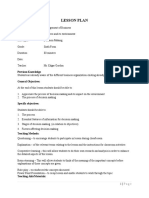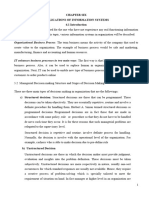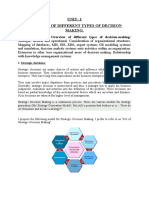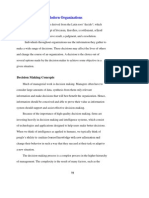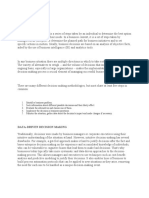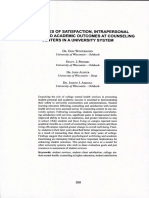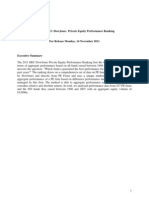0 ratings0% found this document useful (0 votes)
41 viewsIntroduction
This document discusses the importance of statistical skills and statistical thinking in business decision making. It states that managers need to base decisions on data and quantitative analysis rather than just opinions or beliefs. The statistical decision making process involves identifying a problem, building a model to represent the problem, testing the model, and using the model to find a solution. Both quantitative and qualitative factors must be considered in decision making, with quantitative providing numerical analysis and qualitative accounting for less tangible human impacts. The eventual decision balances both quantitative financial impacts and qualitative effects on areas like employee morale.
Uploaded by
Fawad Khan WaseemCopyright
© Attribution Non-Commercial (BY-NC)
Available Formats
Download as PPT, PDF, TXT or read online on Scribd
0 ratings0% found this document useful (0 votes)
41 viewsIntroduction
This document discusses the importance of statistical skills and statistical thinking in business decision making. It states that managers need to base decisions on data and quantitative analysis rather than just opinions or beliefs. The statistical decision making process involves identifying a problem, building a model to represent the problem, testing the model, and using the model to find a solution. Both quantitative and qualitative factors must be considered in decision making, with quantitative providing numerical analysis and qualitative accounting for less tangible human impacts. The eventual decision balances both quantitative financial impacts and qualitative effects on areas like employee morale.
Uploaded by
Fawad Khan WaseemCopyright
© Attribution Non-Commercial (BY-NC)
Available Formats
Download as PPT, PDF, TXT or read online on Scribd
You are on page 1/ 10
Introduction
Business managers and professionals are
increasingly required to justify decisions on the basis of
data. They need statistical model-based decision
support systems.
Statistical skills enable them to intelligently collect,
analyze and interpret data relevant to their decision-
making. Statistical concepts and statistical thinking
enable them to:
Solve problems in a diversity of contexts.
Add substance to decisions.
Reduce guesswork.
Business Statistics is a science assisting you to
make business decisions under uncertainties
Based on some
1 Numerical
2 Measurable scales.
Decision making processes must be based on
data, not on personal opinion nor on belief.
Statistical Decision-Making Process
Identification of a problem through (sample)
Building a decision model
Testing the model
Using the model to find the solution:
It is a simplified representation of the actual situation
It need not be complete or exact in all respects
It concentrates on the most essential relationships and
ignores the less essential ones.
It is more easily understood than the empirical (i.e.,
observed) situation, and hence permits the problem to be
solved more readily with minimum time and effort.
It can be used again and again for similar problems
or can be modified.
The Decision-Making Process
Quantitative and Qualitative Factors
in Decision Making
Quantitative Factors
Quantitative Factors
Provide a numerical basis for decision making
– reduces decisions to looking at a monetary
value placed on different choices, e.g.
Forecasted sales figures
for the next 3 years
The cost of a series of redundancies
against the longer term financial benefits
to the firm of this process
Qualitative Factors
Qualitative Factors
Qualitative factors look to take account of
these other issues
that may influence the outcome
of a decision
Can be wide ranging and especially need to
consider the impact
on human resources and
their response to decisions
Decision Making
Eventual decision may rest on the balance between
the perceived effects of quantitative and qualitative
If the long term effect on the workforce for example
was to reduce productivity or increase absence
because of
the impact on motivation and morale,
the fact that a decision
makes financial sense may be shelved!
Qualitative by its nature, therefore,
is very subjective
You might also like
- Hourglass Workout Program by Luisagiuliet 276% (21)Hourglass Workout Program by Luisagiuliet 251 pages
- The Hold Me Tight Workbook - Dr. Sue Johnson100% (16)The Hold Me Tight Workbook - Dr. Sue Johnson187 pages
- Read People Like A Book by Patrick King-Edited62% (66)Read People Like A Book by Patrick King-Edited12 pages
- Livingood, Blake - Livingood Daily Your 21-Day Guide To Experience Real Health77% (13)Livingood, Blake - Livingood Daily Your 21-Day Guide To Experience Real Health260 pages
- COSMIC CONSCIOUSNESS OF HUMANITY - PROBLEMS OF NEW COSMOGONY (V.P.Kaznacheev,. Л. V. Trofimov.)94% (212)COSMIC CONSCIOUSNESS OF HUMANITY - PROBLEMS OF NEW COSMOGONY (V.P.Kaznacheev,. Л. V. Trofimov.)212 pages
- Donald Trump & Jeffrey Epstein Rape Lawsuit and Affidavits83% (1016)Donald Trump & Jeffrey Epstein Rape Lawsuit and Affidavits13 pages
- The 36 Questions That Lead To Love - The New York Times94% (34)The 36 Questions That Lead To Love - The New York Times3 pages
- The 36 Questions That Lead To Love - The New York Times95% (21)The 36 Questions That Lead To Love - The New York Times3 pages
- Jeffrey Epstein39s Little Black Book Unredacted PDF75% (12)Jeffrey Epstein39s Little Black Book Unredacted PDF95 pages
- The 4 Hour Workweek, Expanded and Updated by Timothy Ferriss - Excerpt23% (954)The 4 Hour Workweek, Expanded and Updated by Timothy Ferriss - Excerpt38 pages
- Module # 3 - MMW Part 1 Central TendencyNo ratings yetModule # 3 - MMW Part 1 Central Tendency22 pages
- Decision Making: BBA Semester-I-Foundation of Business ManagementNo ratings yetDecision Making: BBA Semester-I-Foundation of Business Management6 pages
- Applying Scientific Thinking To Management ProblemsNo ratings yetApplying Scientific Thinking To Management Problems42 pages
- Question 1: Write A Note On Decision Making in Management. How One Will Take Decision Under Risk and UncertaintyNo ratings yetQuestion 1: Write A Note On Decision Making in Management. How One Will Take Decision Under Risk and Uncertainty14 pages
- Management Science: Prof. (DR.) Jagathy Raj V. PNo ratings yetManagement Science: Prof. (DR.) Jagathy Raj V. P105 pages
- Game Theory: Managerial Decision ProcessNo ratings yetGame Theory: Managerial Decision Process9 pages
- Management Information Systems: Slide Set 2: Sabu Francis, (C) 2009, Amplify MindwareNo ratings yetManagement Information Systems: Slide Set 2: Sabu Francis, (C) 2009, Amplify Mindware34 pages
- BUS 4312-Analysis for Business Decisions -Students Note Al-Qalam University_2024_3No ratings yetBUS 4312-Analysis for Business Decisions -Students Note Al-Qalam University_2024_346 pages
- Role of Statistic and Mathametics in Business Decisionmaking75% (4)Role of Statistic and Mathametics in Business Decisionmaking5 pages
- Quantitative Techniques For Decision-MakingNo ratings yetQuantitative Techniques For Decision-Making18 pages
- Doc2 Assignment On Quantitative Business AnalysisNo ratings yetDoc2 Assignment On Quantitative Business Analysis7 pages
- Introduction to Quantitative TechniquesNo ratings yetIntroduction to Quantitative Techniques18 pages
- Chapter No. 3 Decisions and Strategic ModelsNo ratings yetChapter No. 3 Decisions and Strategic Models27 pages
- Marketing Information System Chapter SixNo ratings yetMarketing Information System Chapter Six15 pages
- Unit-1 Overview of Different Types of Decision Making. SyllabusNo ratings yetUnit-1 Overview of Different Types of Decision Making. Syllabus22 pages
- Managing Decision Making and Problem SolveingNo ratings yetManaging Decision Making and Problem Solveing33 pages
- Decision-Making in Modern OrganizationsNo ratings yetDecision-Making in Modern Organizations16 pages
- Strategic Decision Making and Functional Decision MakingNo ratings yetStrategic Decision Making and Functional Decision Making11 pages
- Cut Costs, Grow Stronger : A Strategic Approach to What to Cut and What to KeepFrom EverandCut Costs, Grow Stronger : A Strategic Approach to What to Cut and What to Keep5/5 (1)
- Smart Decisions: Mastering Problem Solving with Strategic Solutions for Business SuccessFrom EverandSmart Decisions: Mastering Problem Solving with Strategic Solutions for Business SuccessNo ratings yet
- Variable Name Variable Abbreviation: ContextNo ratings yetVariable Name Variable Abbreviation: Context1 page
- Benefits of Financial Management SoftwareNo ratings yetBenefits of Financial Management Software6 pages
- Registration and Licensing Investigation and Compliance Management Information System Enforcement DepartmentNo ratings yetRegistration and Licensing Investigation and Compliance Management Information System Enforcement Department4 pages
- Filtering For Speech Enhancement: H H H HNo ratings yetFiltering For Speech Enhancement: H H H H4 pages
- (Shavelson & Webb, 2005) - Generalizability TheoryNo ratings yet(Shavelson & Webb, 2005) - Generalizability Theory14 pages
- A Case Study On Cost Estimation and Pro - Tability Analysis at Continental Airlines PDF0% (1)A Case Study On Cost Estimation and Pro - Tability Analysis at Continental Airlines PDF21 pages
- BPBR7103 Business Research Assignment Jan 2020No ratings yetBPBR7103 Business Research Assignment Jan 202025 pages
- Correlates of Satisfaction, IntrapersonalNo ratings yetCorrelates of Satisfaction, Intrapersonal15 pages
- The 2011 HEC-DowJones PE Performance Ranking ReportNo ratings yetThe 2011 HEC-DowJones PE Performance Ranking Report6 pages
- Lesson 6 Measures of Relative Dispersion Power PointNo ratings yetLesson 6 Measures of Relative Dispersion Power Point8 pages
- PREFACE - Introduction To Linear Regression Analysis, 5th EditionNo ratings yetPREFACE - Introduction To Linear Regression Analysis, 5th Edition4 pages
- A Study On Investors Perception Towards Commodity Futures With Special Reference To Unique Trading Solutions LTD, CoimbatoreNo ratings yetA Study On Investors Perception Towards Commodity Futures With Special Reference To Unique Trading Solutions LTD, Coimbatore11 pages
- Statistics in MS Excel Using MegaStat.30810627No ratings yetStatistics in MS Excel Using MegaStat.3081062725 pages
- NOAKHALI SCIENCE AND TECHNOLOGY UNIVERSITY/SYLLABUS OF ECONOMICS DEPARTMENTNo ratings yetNOAKHALI SCIENCE AND TECHNOLOGY UNIVERSITY/SYLLABUS OF ECONOMICS DEPARTMENT146 pages
- DISS Q1 M2 Social Science As Scientific Study of Society100% (1)DISS Q1 M2 Social Science As Scientific Study of Society23 pages
- CSDS 440: Machine Learning: Soumya Ray (No ratings yetCSDS 440: Machine Learning: Soumya Ray (31 pages
- Scriptie Relation Between Auditor Fees and Earnings ManagementNo ratings yetScriptie Relation Between Auditor Fees and Earnings Management38 pages
- Livingood, Blake - Livingood Daily Your 21-Day Guide To Experience Real HealthLivingood, Blake - Livingood Daily Your 21-Day Guide To Experience Real Health
- COSMIC CONSCIOUSNESS OF HUMANITY - PROBLEMS OF NEW COSMOGONY (V.P.Kaznacheev,. Л. V. Trofimov.)COSMIC CONSCIOUSNESS OF HUMANITY - PROBLEMS OF NEW COSMOGONY (V.P.Kaznacheev,. Л. V. Trofimov.)
- Donald Trump & Jeffrey Epstein Rape Lawsuit and AffidavitsDonald Trump & Jeffrey Epstein Rape Lawsuit and Affidavits
- The 36 Questions That Lead To Love - The New York TimesThe 36 Questions That Lead To Love - The New York Times
- The 36 Questions That Lead To Love - The New York TimesThe 36 Questions That Lead To Love - The New York Times
- Jeffrey Epstein39s Little Black Book Unredacted PDFJeffrey Epstein39s Little Black Book Unredacted PDF
- The 4 Hour Workweek, Expanded and Updated by Timothy Ferriss - ExcerptThe 4 Hour Workweek, Expanded and Updated by Timothy Ferriss - Excerpt
- Decision Making: BBA Semester-I-Foundation of Business ManagementDecision Making: BBA Semester-I-Foundation of Business Management
- Applying Scientific Thinking To Management ProblemsApplying Scientific Thinking To Management Problems
- Question 1: Write A Note On Decision Making in Management. How One Will Take Decision Under Risk and UncertaintyQuestion 1: Write A Note On Decision Making in Management. How One Will Take Decision Under Risk and Uncertainty
- Management Information Systems: Slide Set 2: Sabu Francis, (C) 2009, Amplify MindwareManagement Information Systems: Slide Set 2: Sabu Francis, (C) 2009, Amplify Mindware
- BUS 4312-Analysis for Business Decisions -Students Note Al-Qalam University_2024_3BUS 4312-Analysis for Business Decisions -Students Note Al-Qalam University_2024_3
- Role of Statistic and Mathametics in Business DecisionmakingRole of Statistic and Mathametics in Business Decisionmaking
- Unit-1 Overview of Different Types of Decision Making. SyllabusUnit-1 Overview of Different Types of Decision Making. Syllabus
- Strategic Decision Making and Functional Decision MakingStrategic Decision Making and Functional Decision Making
- Cut Costs, Grow Stronger : A Strategic Approach to What to Cut and What to KeepFrom EverandCut Costs, Grow Stronger : A Strategic Approach to What to Cut and What to Keep
- Smart Decisions: Mastering Problem Solving with Strategic Solutions for Business SuccessFrom EverandSmart Decisions: Mastering Problem Solving with Strategic Solutions for Business Success
- Registration and Licensing Investigation and Compliance Management Information System Enforcement DepartmentRegistration and Licensing Investigation and Compliance Management Information System Enforcement Department
- (Shavelson & Webb, 2005) - Generalizability Theory(Shavelson & Webb, 2005) - Generalizability Theory
- A Case Study On Cost Estimation and Pro - Tability Analysis at Continental Airlines PDFA Case Study On Cost Estimation and Pro - Tability Analysis at Continental Airlines PDF
- The 2011 HEC-DowJones PE Performance Ranking ReportThe 2011 HEC-DowJones PE Performance Ranking Report
- Lesson 6 Measures of Relative Dispersion Power PointLesson 6 Measures of Relative Dispersion Power Point
- PREFACE - Introduction To Linear Regression Analysis, 5th EditionPREFACE - Introduction To Linear Regression Analysis, 5th Edition
- A Study On Investors Perception Towards Commodity Futures With Special Reference To Unique Trading Solutions LTD, CoimbatoreA Study On Investors Perception Towards Commodity Futures With Special Reference To Unique Trading Solutions LTD, Coimbatore
- NOAKHALI SCIENCE AND TECHNOLOGY UNIVERSITY/SYLLABUS OF ECONOMICS DEPARTMENTNOAKHALI SCIENCE AND TECHNOLOGY UNIVERSITY/SYLLABUS OF ECONOMICS DEPARTMENT
- DISS Q1 M2 Social Science As Scientific Study of SocietyDISS Q1 M2 Social Science As Scientific Study of Society
- Scriptie Relation Between Auditor Fees and Earnings ManagementScriptie Relation Between Auditor Fees and Earnings Management









































